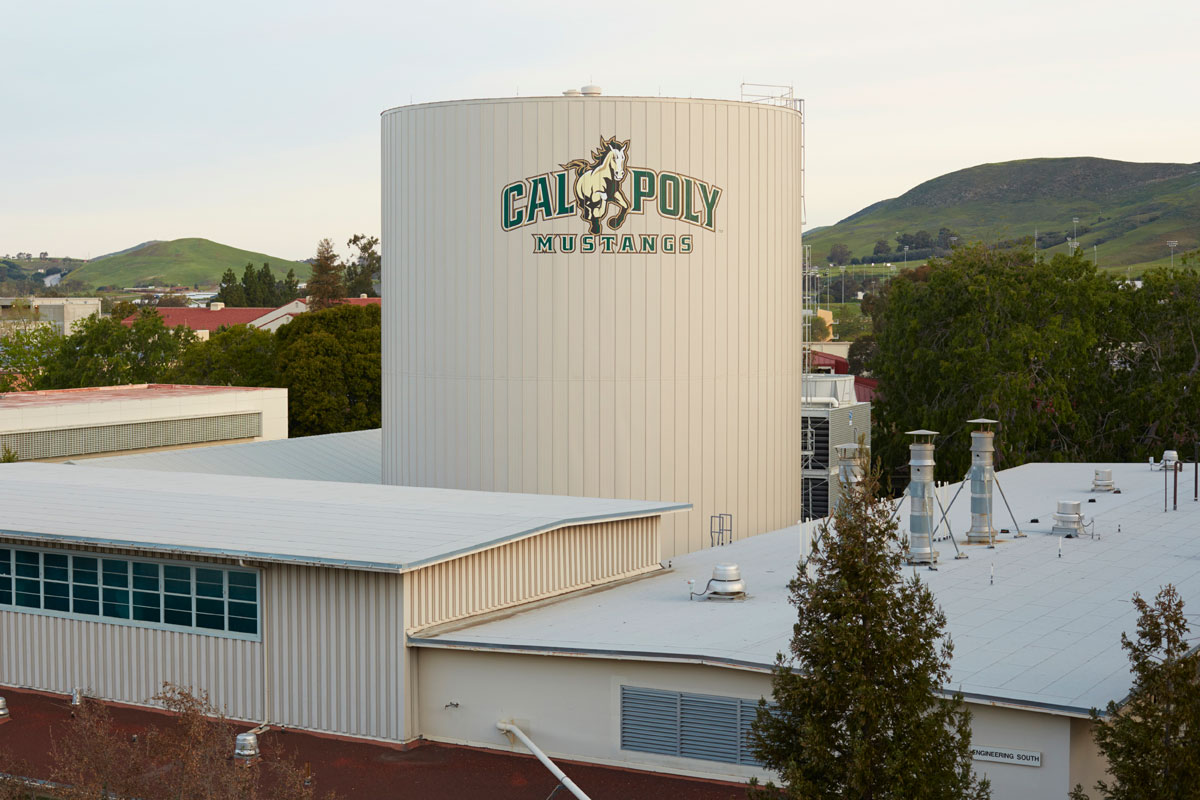Electricity
 The majority of electricity use on campus is for lighting and HVAC (Heating, Ventilation, and Air Conditioning). Cal Poly purchases approximately 68% of its electricity needs from Pacific Gas and Electric Company, and generates the other 32% on site from a combination of solar PV, most coming from the Gold Tree Solar Farm and cogeneration. Cal Poly has implemented numerous energy conservation projects to reduce electrical usage, including fluorescent and LED lighting retrofits, occupancy sensors, HVAC equipment upgrades, variable frequency drives for pumps and fans, and installation of digital energy management systems. In spite of the fact that the campus square footage has grown dramatically in recent years, electricity use has remained relatively flat – indicating that conservation efforts have been able to offset growth. Electricity costs have escalated rapidly in recent years due to utility rate increases, more than doubling since 2002.
The majority of electricity use on campus is for lighting and HVAC (Heating, Ventilation, and Air Conditioning). Cal Poly purchases approximately 68% of its electricity needs from Pacific Gas and Electric Company, and generates the other 32% on site from a combination of solar PV, most coming from the Gold Tree Solar Farm and cogeneration. Cal Poly has implemented numerous energy conservation projects to reduce electrical usage, including fluorescent and LED lighting retrofits, occupancy sensors, HVAC equipment upgrades, variable frequency drives for pumps and fans, and installation of digital energy management systems. In spite of the fact that the campus square footage has grown dramatically in recent years, electricity use has remained relatively flat – indicating that conservation efforts have been able to offset growth. Electricity costs have escalated rapidly in recent years due to utility rate increases, more than doubling since 2002.
 Cal Poly has 26 different electric service accounts – two serving the main campus through the University owned Mustang Substation (representing 98% of all electric purchase), and the remainder serving a variety of remote sites including ranch houses, irrigation wells and pumps, and remote street lights (representing 2% of all electric purchase). Power is received from PG&E at a transmission level of 70,000 volts, and is transformed at Mustang Substation to either 12,470 volts or 4,160 volts for distribution to campus buildings. Electrical distribution in the campus core is all underground, while distribution to outlying Ag areas is via overhead lines. Mustang Substation and all campus distribution systems are owned by the University and maintained by the campus Electric Shop. Power is purchased from PG&E on the E20T Tariff, which includes separate charges for energy and peak demand, and different time of use periods for peak/part peak/off peak and winter/summer seasons.
Cal Poly has 26 different electric service accounts – two serving the main campus through the University owned Mustang Substation (representing 98% of all electric purchase), and the remainder serving a variety of remote sites including ranch houses, irrigation wells and pumps, and remote street lights (representing 2% of all electric purchase). Power is received from PG&E at a transmission level of 70,000 volts, and is transformed at Mustang Substation to either 12,470 volts or 4,160 volts for distribution to campus buildings. Electrical distribution in the campus core is all underground, while distribution to outlying Ag areas is via overhead lines. Mustang Substation and all campus distribution systems are owned by the University and maintained by the campus Electric Shop. Power is purchased from PG&E on the E20T Tariff, which includes separate charges for energy and peak demand, and different time of use periods for peak/part peak/off peak and winter/summer seasons.
 As a PG&E customer, Cal Poly procures some of the cleanest energy in the nation. PG&E reported for 2018 that 39 percent of the electricity supplied to customers came from renewable resources that qualify under California’s Renewables Portfolio Standard (solar, wind, geothermal, biomass, and small hydro). When large hydro and nuclear are factored in, over 85 percent of the total energy sourced by PG&E is greenhouse gas free. As of June 2016, PG&E has announced plans to shut down Diablo Canyon Nuclear Power Plant and replace it more cost effectively with energy efficiency, renewables, and energy storage.
As a PG&E customer, Cal Poly procures some of the cleanest energy in the nation. PG&E reported for 2018 that 39 percent of the electricity supplied to customers came from renewable resources that qualify under California’s Renewables Portfolio Standard (solar, wind, geothermal, biomass, and small hydro). When large hydro and nuclear are factored in, over 85 percent of the total energy sourced by PG&E is greenhouse gas free. As of June 2016, PG&E has announced plans to shut down Diablo Canyon Nuclear Power Plant and replace it more cost effectively with energy efficiency, renewables, and energy storage.
